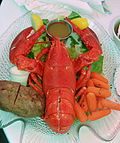American lobster
Detailed article on the American lobster
The American lobster (Homarus americanus), also known as the Maine lobster, is a species of lobster found on the Atlantic coast of North America, primarily from Labrador to New Jersey. It is a highly valued seafood and is known for its large size and delicious taste.
Description
The American lobster is characterized by its robust body, large claws, and a hard exoskeleton. It can grow to a length of over 60 cm (24 inches) and weigh more than 20 kg (44 lbs), although such sizes are rare. The body color of the lobster can vary, but it is typically a dark bluish green to greenish brown, with redder hues on the claws.
Habitat
American lobsters inhabit the cold, shallow waters of the continental shelf. They are found at depths ranging from the intertidal zone to about 480 meters (1,570 feet). Lobsters prefer rocky substrates where they can hide from predators and hunt for food.
Diet
Lobsters are omnivorous and feed on a variety of prey, including fish, mollusks, other crustaceans, and even plant material. They are known to be opportunistic feeders, scavenging for food when necessary.
Reproduction
The reproductive cycle of the American lobster involves complex behaviors. Mating typically occurs after the female molts, as her new shell is soft and allows for successful copulation. Females carry fertilized eggs under their tails for 9 to 12 months before hatching.
Economic Importance
The American lobster is a significant part of the fishing industry in North America. It is a major source of income for coastal communities and is considered a delicacy worldwide. The lobster industry is regulated to ensure sustainable harvesting practices.
Conservation
Efforts to conserve lobster populations include size limits, trap limits, and closed seasons. These measures help maintain healthy lobster stocks and ensure the long-term viability of the fishery.
Gallery
Related pages
Transform your life with W8MD's budget GLP-1 injections from $125.
W8MD offers a medical weight loss program to lose weight in Philadelphia. Our physician-supervised medical weight loss provides:
- Most insurances accepted or discounted self-pay rates. We will obtain insurance prior authorizations if needed.
- Generic GLP1 weight loss injections from $125 for the starting dose.
- Also offer prescription weight loss medications including Phentermine, Qsymia, Diethylpropion, Contrave etc.
NYC weight loss doctor appointments
Start your NYC weight loss journey today at our NYC medical weight loss and Philadelphia medical weight loss clinics.
- Call 718-946-5500 to lose weight in NYC or for medical weight loss in Philadelphia 215-676-2334.
- Tags:NYC medical weight loss, Philadelphia lose weight Zepbound NYC, Budget GLP1 weight loss injections, Wegovy Philadelphia, Wegovy NYC, Philadelphia medical weight loss, Brookly weight loss and Wegovy NYC
|
WikiMD's Wellness Encyclopedia |
| Let Food Be Thy Medicine Medicine Thy Food - Hippocrates |
Medical Disclaimer: WikiMD is not a substitute for professional medical advice. The information on WikiMD is provided as an information resource only, may be incorrect, outdated or misleading, and is not to be used or relied on for any diagnostic or treatment purposes. Please consult your health care provider before making any healthcare decisions or for guidance about a specific medical condition. WikiMD expressly disclaims responsibility, and shall have no liability, for any damages, loss, injury, or liability whatsoever suffered as a result of your reliance on the information contained in this site. By visiting this site you agree to the foregoing terms and conditions, which may from time to time be changed or supplemented by WikiMD. If you do not agree to the foregoing terms and conditions, you should not enter or use this site. See full disclaimer.
Credits:Most images are courtesy of Wikimedia commons, and templates, categories Wikipedia, licensed under CC BY SA or similar.
Contributors: Prab R. Tumpati, MD











